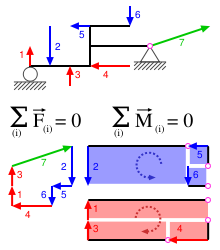
Example of a beam in static equilibrium. The sum of
force and moment is zero.
Statics is the branch of physics concerned with the analysis of
loads (force,
torque/moment)
on
physical systems in
static equilibrium, that is, in a state where the relative positions of
subsystems do not vary over time, or where components and structures are at
rest under the action of external forces of equilibrium. In other words it
is how forces are transmitted through the members in an object such as a
crane from where it is applied on the object, the hanging end, to where it
is supported from, the base of the crane. When in static equilibrium, the
system is either at rest, or moving at constant velocity through its
center of mass.
By
Newton's second law, this situation implies that the net force and net
torque
(also known as moment) on every body in the system is zero, meaning that for
every force bearing upon a member, there must be an equal and opposite
force. From this constraint, such quantities as
stress or
pressure
can be derived. The net forces equalling zero is known as the first
condition for equilibrium, and the net torque equalling zero is known as
the second condition for equilibrium. See
statically determinate.
Statics is thoroughly used in the analysis of structures, for instance in
architectural and
structural engineering.
Strength of materials is a related field of mechanics that relies
heavily on the application of static equilibrium.
Hydrostatics, also known as
fluid statics, is the study of fluids at rest. This analyzes systems in
static equilibrium which involve forces due to mechanical fluids. The
characteristic of any fluid at rest is that the force exerted on any
particle of the fluid is the same in every direction. If the force is
unequal the fluid will move in the direction of the resulting force. This
concept was first formulated in a slightly extended form by the
French
mathematician and
philosopher
Blaise Pascal in
1647 and would
be later known as
Pascal's Law. This law has many important applications in
hydraulics. Galileo also was a major figure in the development of
hydrostatics.
In
economics, "static" analysis has substantially the same meaning as in
physics. Since the time of
Paul Samuelson's
Foundations of Economic Analysis (1947), the focus has been on "comparative
statics", i.e., the comparison of one
static equilibrium to another, with little or no discussion of the
process of going between them � except to note the
exogenous changes that caused the movement.
In
exploration geophysics, "statics" is used as a short form for "static
correction", referring to bulk time shifts of a
reflection
seismogram to correct for the variations in elevation and velocity of
the
seismic pulse through the
weathered and
unconsolidated upper layers.